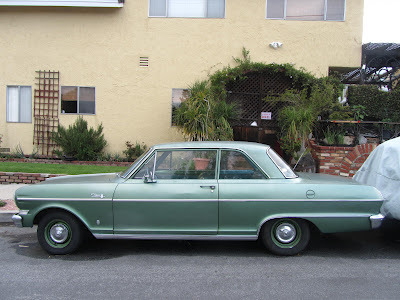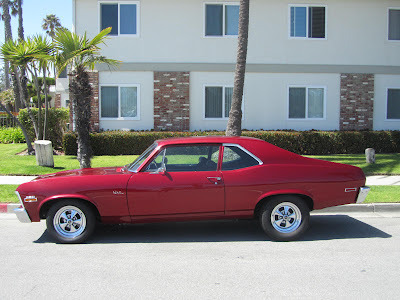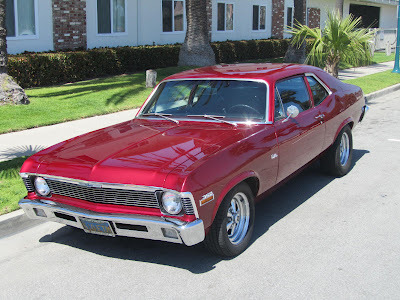Peter Behrens's Blog, page 499
November 14, 2013
FORD F-2. Yates Center, Kansas
Published on November 14, 2013 19:03
Chevy II and Chevy Nova
Just back from book-touring in California. Taped an interview for Michael Silverblatt's Bookworm program; it will air in two or three weeks. When I wasn't talking about, or reading from, The O'Briens I was of course looking for machines. I've got a bunch of photographs, and will sort them out, but, in the meantime, here are a couple of baby Chevys.
The first is a very, very clean Chevy II which was the series that, after a year or two, spawned the first Nova. This car, parked on a street in Mar Vista, looks amazingly original, including the plain-Jane interior. I would guess that its the 1962 edition. Yikes! that means its half a century old! Love the basic-ness and cleanness of the car; the Chevy II was GM's answer to the Ford Falcon.


 And here's another Chevy II (sorry, Nova) I caught on the street in Carpinteria that's anything but basic. My guess is 1969 or 1970.
And here's another Chevy II (sorry, Nova) I caught on the street in Carpinteria that's anything but basic. My guess is 1969 or 1970.
That paint didn't come out of the factory paintshop; neither did those wheels. The tires aren't standard-issue either. This is a lean, clean, semi-street racing machine and very Californian in its get-down-to-business aesthetic. Something deep in the California car aesthetic seems borrowed, inspire or inhaled from the fact of car guys growing up and living beside the Pacific coast--the long, powerful, bare, almost barren look of those west coast beaches. The air sometimes silver with mist, and usually cooler than you would expect. Sometimes the mist is gone, and then the light is pellucid. Almost too sharp a light to question. It's an action-oriented coastline: all that surfing, all those shoreline highways. The Pacific there has a sharp tangy smell, a bit astringent--like gasoline?--quite different than the gamey scent of the gentler, wilier seas here in Maine. The ocean out there seems relentless as it booms in those long, thumping waves from Hawaii or Japan.
Jim Donnelly offers vignettes of California car history in Hemmings Classic Car, June 2012:
"Kids hauling jalopies up to the high desert to run on the dry lakes, the earliest freeways, surfers in castoff woodie wagns, countless people who did shift work at Van Nuys and Pico Rivera, Johnny von Neumann selling Porsches, Top Fuel diggers smoking 'em all the way to the Long Beach finish line, Harley Earl doing custom coachwork for Don Lee, Offenhausers by Meyer-Drake winning Indy 26 times, smog, the creation of artworks with lead and Carson tops, the lowriders of La Raza"--
Anyway I like the way clean California street machines look. Never overdressed.

Didn't peek under the hood to see what was going on but this car left the factory with the venerable Chevrolet 350 engine, which would have provided considerable momentum even before a tuning. The thing I like about it is that California cleanness. The absence of gewgaws. Looks like maybe a billet grill--don't like those much--and that chrome strip on the rear window is not original, and is not needed, and should be deleted immeidately---but otherwise the exterior has been left alone. It's possible that the car originally had chrome side-strips and these have been removed. Good. Both of my Chevrolets of that era (a 1969 Brookwood wagon, and the 1975 C10 truck) were improved in looks and vibe by subtracting the chrome side ding-strips. They affected the whole gestalt of the car. Chevrolets--cars and pickups--of that era look much, much sleeker without them.
The red metallic paint is beautiful and actually subtle, for a red. The black interior--bench seat, column shift--looks original, or restored to near-original. It's fastidious. Plain jane. It's the sort of car that a high school principal might have owned, out of the factory. A sleeper.
Book notes: The O'Briens, my new novel, ("a major accomplishment" The New York Times) has just gone into a second printing. It is available on Amazon, of course, but some stores around the countrystill have signed first editions in stock, and a list of them is up here.
The first is a very, very clean Chevy II which was the series that, after a year or two, spawned the first Nova. This car, parked on a street in Mar Vista, looks amazingly original, including the plain-Jane interior. I would guess that its the 1962 edition. Yikes! that means its half a century old! Love the basic-ness and cleanness of the car; the Chevy II was GM's answer to the Ford Falcon.


 And here's another Chevy II (sorry, Nova) I caught on the street in Carpinteria that's anything but basic. My guess is 1969 or 1970.
And here's another Chevy II (sorry, Nova) I caught on the street in Carpinteria that's anything but basic. My guess is 1969 or 1970.That paint didn't come out of the factory paintshop; neither did those wheels. The tires aren't standard-issue either. This is a lean, clean, semi-street racing machine and very Californian in its get-down-to-business aesthetic. Something deep in the California car aesthetic seems borrowed, inspire or inhaled from the fact of car guys growing up and living beside the Pacific coast--the long, powerful, bare, almost barren look of those west coast beaches. The air sometimes silver with mist, and usually cooler than you would expect. Sometimes the mist is gone, and then the light is pellucid. Almost too sharp a light to question. It's an action-oriented coastline: all that surfing, all those shoreline highways. The Pacific there has a sharp tangy smell, a bit astringent--like gasoline?--quite different than the gamey scent of the gentler, wilier seas here in Maine. The ocean out there seems relentless as it booms in those long, thumping waves from Hawaii or Japan.
Jim Donnelly offers vignettes of California car history in Hemmings Classic Car, June 2012:
"Kids hauling jalopies up to the high desert to run on the dry lakes, the earliest freeways, surfers in castoff woodie wagns, countless people who did shift work at Van Nuys and Pico Rivera, Johnny von Neumann selling Porsches, Top Fuel diggers smoking 'em all the way to the Long Beach finish line, Harley Earl doing custom coachwork for Don Lee, Offenhausers by Meyer-Drake winning Indy 26 times, smog, the creation of artworks with lead and Carson tops, the lowriders of La Raza"--
Anyway I like the way clean California street machines look. Never overdressed.

Didn't peek under the hood to see what was going on but this car left the factory with the venerable Chevrolet 350 engine, which would have provided considerable momentum even before a tuning. The thing I like about it is that California cleanness. The absence of gewgaws. Looks like maybe a billet grill--don't like those much--and that chrome strip on the rear window is not original, and is not needed, and should be deleted immeidately---but otherwise the exterior has been left alone. It's possible that the car originally had chrome side-strips and these have been removed. Good. Both of my Chevrolets of that era (a 1969 Brookwood wagon, and the 1975 C10 truck) were improved in looks and vibe by subtracting the chrome side ding-strips. They affected the whole gestalt of the car. Chevrolets--cars and pickups--of that era look much, much sleeker without them.
The red metallic paint is beautiful and actually subtle, for a red. The black interior--bench seat, column shift--looks original, or restored to near-original. It's fastidious. Plain jane. It's the sort of car that a high school principal might have owned, out of the factory. A sleeper.
Book notes: The O'Briens, my new novel, ("a major accomplishment" The New York Times) has just gone into a second printing. It is available on Amazon, of course, but some stores around the countrystill have signed first editions in stock, and a list of them is up here.
Published on November 14, 2013 19:00
Bill Burleson: Kinds of Light, New Mexico
1. Aspens in Morning Light2. Ruins, Chaco Canyon3. Galisteo NM4. Abandoned House, Romeroville NM5. Kitchen MEas, Ghost Ranch NM6. Valdez NM












Published on November 14, 2013 14:31
Maura O'Connell "Western Highway"
Published on November 14, 2013 06:13
1962 Valiant Wichita
Published on November 14, 2013 06:09
“I would really rather feel bad in Maine than feel good anywhere else” ― E.B. White
Published on November 14, 2013 06:01
November 13, 2013
One-room Schoolhouse, Ohio Twp., Franklin Co., Kansas
Published on November 13, 2013 06:34
1943 Ford Truck, 1 1/2 ton, Richmond Kansas
Published on November 13, 2013 06:31
November 12, 2013
Bleeding Kansas: John Brown country

Went looking for the ghost of John Brown in eastern Kansas last weekend. Have you read Russell Banks' novel about Brown, Cloudsplitter? It's a remarkable book. We drove along John Brown Road to Pottawatomie Creek, where JB murdered those proslavery men, and at Osawatomie spent some time on the 'battlefield' where he and his crew fought off a force of Missourians. He's a strange figure in American history---he certainly can be seen as a jihadi, an ideological warrior, willing to kill and die for his beliefs, which were grounded in his interpretation of God's will...also as an American hero. Though I'm getting awfully tired of that phrase "American hero" these days.


 The Pottawatomie Massacre happened at this bend in the creek.
The Pottawatomie Massacre happened at this bend in the creek.

 Post Office, Pottawatomie Twonship
Post Office, Pottawatomie Twonship



Published on November 12, 2013 18:53
The Apartment Kate Northrop Poem

The Apartment
Remember the Worcester apartment: third floor of a three-family, in the upper reaches of the elms. Whole afternoonscould still in it, each room
oddly bright inside, like the bloom at the top of a hollyhock.
.
I remember the apartment, third floor “like a tree-house” but the layoutforcing a certain passage, a tight
loop: entering into the living room, you turned
right through an arch, into the dining room, and then againthrough another, smaller arch
into the kitchen in the back, crammed inunder crooked eaves. Plotted like a child’s story (and just then--) each room
offered a second door, a way onward: through the kitchen right into the bedroom, through bedroom into the dark,
paneled hall, which ended, at the front door again. Afternoons you could sit
in the filtered light, obliteratingas a perfect argument. Or watch the leaves rustle, but it was too weird, being up there, eventually
like being a breath. Like being only the thought
your mind was having.
.
The rain thumps against the house. It thumpson the side of the house. Thumps against it--
In a thicket, a damp grey rabbit blinks. That is to say,in the pause before the boat responds--
I remember your apartment, more peculiarby night (the candles
only worsened it, a flame disappearing in the apartment’s distance, then reappearing,like a fire at the far end of a field) and I moved through quietly
like blood in an artery, exceptthere was nothing at the center, there was
no center there at all, only
the sound of you, turning over, and a car door slammed below. Often in those moments I imagined the children. And now they are beautiful, stretched on the floor, chinsin their perfect hands. Now they are watching
this huge, speckled TV-- silver TV
.
And Love, I hear you, but I am tired (so tired!) of sky that comes down in snow
There must be something to believe
But I know there is nothing to believe
-Kate Northrop
Published on November 12, 2013 15:27










































